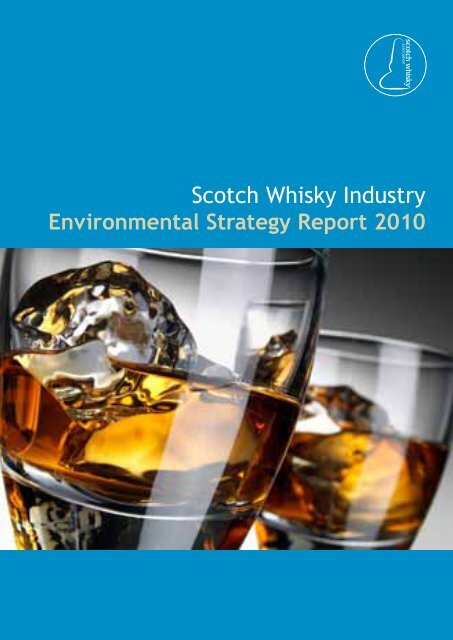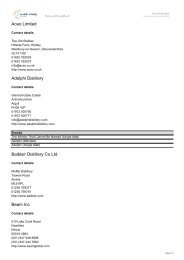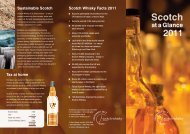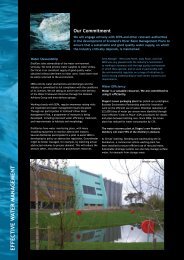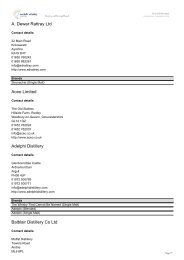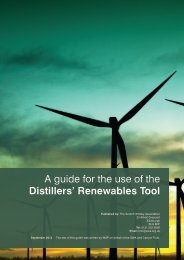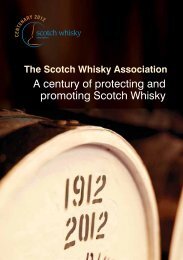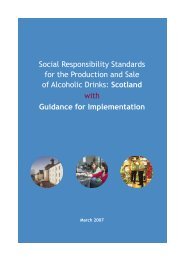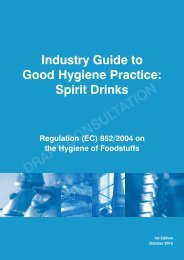Scotch Whisky Industry - Scotch Whisky Association
Scotch Whisky Industry - Scotch Whisky Association
Scotch Whisky Industry - Scotch Whisky Association
- No tags were found...
Create successful ePaper yourself
Turn your PDF publications into a flip-book with our unique Google optimized e-Paper software.
<strong>Scotch</strong> <strong>Whisky</strong> <strong>Industry</strong>Environmental Strategy Report 2010
Reducing Greenhouse Gas Emissions and Relianceon Fossil FuelsCOMMITMENT: We will continue to mitigate our greenhouse gas emissions to theatmosphere and to increase our energy efficiency in the production process, throughinnovation and adoption of relevant technologies.The process of distilling is energy intensive requiring much heat energy to fire the stills,driving distillation.Energy efficiency is expressed as the amount of Primary Energy used to produce either new-makespirit in our distilleries, or cased goods in our packaging operations. This is known as SpecificEnergy Consumption (SEC). The average SEC for distilling and maturation is 6.83 kWh/lpa. In ourpackaging operations, the average SEC is 3.21 kWh/9 litre case equivalent.Reducing Greenhouse Gas Emissions and Reliance on Fossil FuelsPrimary energyusageGreenhouse gasemissionsPrimary productionenergy efficiencyPackaging energyefficiencyNon-fossil fuel primaryenergy usage3,619,101,208 kWh (equivalent to 0.14% of total UK primary energy consumption in 2008)751,239 tonnes CO 2e (equivalent to 0.12% total UK emissions in 2008)6.83 kWh/lpa3.21 kWh/9l case equivalent3%This data is new for the industry. Previously we have reported energy efficiency data for distilleriesin the wider spirits sector (including gin and vodka). This is because The <strong>Scotch</strong> <strong>Whisky</strong> <strong>Association</strong>manages the spirits industry’s Climate Change Agreement (CCA) on behalf of the whole spiritssector. Our Environment Strategy however focuses on <strong>Scotch</strong> <strong>Whisky</strong> production, and so, for the firsttime, the data here refers only to energy used in the production of <strong>Scotch</strong> <strong>Whisky</strong>. This establishes arobust baseline for making comparisons in future years.<strong>Scotch</strong> <strong>Whisky</strong> accounts for 88% of the spirit sector’s CCA production. Participation in thatAgreement has led to an improvement in energy efficiency of 18% since 1999 for the spirits sectoras a whole while production has increased by 22%. Much of that improvement can be attributed to<strong>Scotch</strong> <strong>Whisky</strong> distillers.2
COMMITMENT: By 2020 we will ensure that 20% of the industry’s primary energyrequirements will be derived from non-fossil fuel sources, with a target of 80% by2050, thereby reducing greenhouse gas emissions from fossil fuel sources to aminimal level.Primary Energy UsageThis is by far our most stretching target. In 2008, fossil fuels accounted for 97% of our total primaryenergy requirements. The remaining 3% was from non-fossil fuel grid electricity sources.Our baseline for 2008 demonstrates a major challenge for the <strong>Scotch</strong> <strong>Whisky</strong> industry. By next year,we will see considerable improvement on 2008 performance against this target, as data from atleast two major industry investments in biogas energy plants that were commissioned in 2009 willbe reflected.The <strong>Scotch</strong> <strong>Whisky</strong> industry uses a mix of fuel types. A large number of malt distilleries are locatedin remote areas away from the gas grid and are reliant on heavy fuel oil. In 2008, natural gasaccounted for 58% of the industry’s energy inputs, heavy fuel oil 21%, electricity 20% and other fuelsaround 1%. In terms of the impact of the industry’s energy use, however, natural gas represents 51%of our emissions, heavy fuel oil 27%, electricity 20% and others 2%.Energy Usage and Associated Emissions3
Water ManagementThe Life Cycle Assessment of <strong>Scotch</strong> <strong>Whisky</strong>COMMITMENT: We will manage our water requirements effectively.In 2008, the industry used a totalof 61,449,515m 3 of water. Acrossthe industry, 75% of this was usedfor cooling and returned to theenvironment. In malt distilling, thisfigure rises to 85%. The industry’stotal net water use (water that ispermanently abstracted and notreturned to the environment) in2008 was 15,584,937m 3 , of whichmalt distilling accounted for 52%,grain distilling 37% and bottling 4%.Distilling accounted for 89% of thewater we used.What is a Life Cycle Assessment?1A Life Cycle Assessment (or an LCA) is defined by an International Standard as“ compilation and evaluation of the inputs, outputs and potential environmsystem throughout its life cycle”It is a helpful tool for evaluating the environmental impact of a product at all sfrom extraction of resources, through production of materials, to use and dispoData for 2008 demonstrates that the vast majority (79%) of the industry’s water requirements weresourced from private sources (such as boreholes and rivers). The remaining 21% came from theWhy perform a Life Cycle Assessment of <strong>Scotch</strong> <strong>Whisky</strong>?public water supply.The application of a Life Cycle Assessment to <strong>Scotch</strong> <strong>Whisky</strong> provides a numberCOMMITMENT: We will engage actively with SEPA and other relevant authoritiesin the development of Scotland’s River Basin Management Plans to ensure that aIt establishes a baseline against which continued industry efforts towards resustainable and good quality water supply, on which the industry critically depends,impact can be reliably measured.is maintained.It identifies opportunities to improve environmental performance at variousManagement of the water environment is something distillers take seriously. We rely on good qualityas well assessing the impact (whether positive or negative) of proposed impwater to make our quality products. The <strong>Scotch</strong> <strong>Whisky</strong> industry has welcomed the publication oflife cycle.Scotland’s River Basin Management Plans and was involved actively in their development, throughSEPA’s National Advisory Group as a key business stakeholder. A workshop was held with SEPA inLCA design and performance is based on recognised protocols such as the ISFebruary 2009 to identify where measures were necessary to bring about improvements in water2Assessments and PAS 2050:2008.courses impacted by distilleries. The published Scotland River Basin Management Plan reports thatthe event enhanced the co-operation between SEPA and the distilling sector and that a range ofA Life Cycle Assessment allows the industry to engage with stakeholders onissues were resolved through clarification of activities on a site-by-site basis.auditable data. This will benefit working with partners in the supply chain oinfluence areas over which the industry has no direct control.Packaging Materials and WasteCOMMITMENT: By 2020 we will reduce by 10% the average unit weight of ourproduct packaging materials.Packaging plays an important role in containing, protecting and presenting <strong>Scotch</strong> <strong>Whisky</strong>, a highvalue consumer product.1 ISO 14040:2006 - “Environmental management - Life cycle assessment – Principles and framewo2 BSI PAS 2050:2006 - “Specification for the assessment of the life cycle greenhouse gas emission4
The North British Distillery: Case StudyThe Edinburgh-based The North BritishDistillery Company Ltd. embarked on itsSustainability Project at the end of 2009.The Gorgie grain distillery, the secondlargest in the industry, is a joint venturebetween The Edrington Group and Diageoand supplies to some of the most famousspirit brands including The Famous Grouseand J&B.Key objectives were identified as criticalto the future sustainability of distilleryoperations; to reduce the energy profile ofthe business and to reduce the environmentalfootprint and impact of spirit production.The project will be managed in a stagedapproach that will require each stage tobe verified on its technical capability andefficiency of operation before proceedingto the next. Subsequent stages will only beprogressed where clear future economicbenefits can be identified.Stage one involves the installation of ananaerobic digester to convert evaporatorcondensate from the distillers dark grainsprocess, grey water and spent wash centrateinto biogas. A dedicated biogas boiler willburn the gas to produce process steam.Stage two will see the expansion of the newanaerobic digestion plant and the installationof a new water treatment plant (WTP) toprocess effluent from the digester. The WTPwill improve effluent quality and provideclean water which can be recycled back intothe process. The final stage will involve theinstallation of a gas engine derived combinedheat and power (CHP) plant to produceelectricity from the biogas.The project seeks to produce up to 1MWeof renewable electrical energy, save 1MWethrough less intensive energy use of theexisting evaporation plant and recycle 40%of the effluent produced by the distilleryback into the process. Implementation of theproject will reduce CO 2emissions by 9000tonnes per year (equivalent to driving aroundthe world 1415 times).The distillery’s aspiration is to expand itsanaerobic digestion and electrical generationcapacity to 3MWe so that it will be a nonimporterof electrical energy.AD plant under construction9
Chivas Brothers: Case StudyChivas Brothers is the <strong>Scotch</strong> <strong>Whisky</strong> andpremium gin business of Pernod Ricard.The company produces, exports, and marketssome of the world’s best known malts andblends, including Chivas Regal, Ballantine’s,The Glenlivet and Royal Salute.For many years, Chivas Regal 12 Years Old waspackaged in gift cartons for sale in China. Itbecame apparent that when the brand was soldin bars and restaurants, the gift cartons wereimmediately discarded. Consumers never sawnor appreciated them. The sellers also had todispose of the wasted cartons.about 460g/case, packaging weight has beenreduced by a total of up to 200 tonnes per year.Apart from significant raw material and wastereductions, the initiative has led to otherresource and energy savings, including lessprocessing of board and less ink, varnishesand transport.Working with the distributor (Pernod RicardChina), the company switched to supply packsfor this market and trade channel withoutthe gift cartons. Over 80% of the brand is nowdistributed to this market in “drop-in” (withdivisions) cases. With around half a millioncases shipped per year and a weight saving of10
The Edrington Group: Case StudyThe Edrington Group distils, blends and bottlessome of the most famous <strong>Scotch</strong> <strong>Whisky</strong> brandsin the world, including premium single maltsThe Macallan and Highland Park, and leadingblends The Famous Grouse and Cutty Sark.The company’s Great Western Road headquartersand bottling plant, in the west end of Glasgow,handles over 85 million bottles of <strong>Scotch</strong> <strong>Whisky</strong>every year while the cased goods warehousehandles over 7 million cases per annum andservices over 100 overseas markets.The group’s skilled and experienced workforceoperates within the internationally recognisedquality, environmental and health and safetystandards ISO9001:2008, ISO14001 and BS:OHSAS18001. The company aims to deliverproducts to the highest manufacturing standards.This commitment takes account of various issuesassociated with the supply chain, especiallyenvironmental impacts.The company has embedded a number of recentinitiatives into its distribution strategy:In collaboration with its UK distributor,Maxxium, the company has implementeddirect deliveries from its whisky warehouseto the Regional Distribution Centres (RDCs)of major retailers. This not only reducesdefg1. EDRINGTON LOGOBlack and White Logo abc Font Size 481. Select Edrington Logo font2. Type ʻabcʼ.3. To change the size, highlight the logo and change the font size to suit.Colour Logo defg Font Size 481 Select Edrington Logo font2 Choose Format from the menu bar and select Font3 Choose Black in the Font color box and click OKlocal haulage to the4 Typedistributor’sʻdʼ (part of The EdringtonwarehouseGroup will appear)5 Change the Font color to Goldbut also handling, 6 storage Type ʻeʼ (the gold and logo will redistributionappear)7 Change the Font color to Dark Blue8 Type ʻfʼ (the dark blue background will appear)activities. The adoption 9 Change the of Font color night to Black time10 Type ʻgʼ (the Edrington logo is completed)deliveries during the seasonal peak (October-December) to Maxxium’s local RDC has helpedease road congestion during peak traffictimes.11 To change the size, highlight the logo and change the font size to suit.Where possible, the Scottish ports ofGreenock or Grangemouth are used to avoidunnecessary road miles to southern docks.Edrington has also switched from road to railwherever possible a recent example beingIntermodal movements to France, whichfurther reduces road miles.Edrington looks to maximise export shipmentswherever possible. A new computerisedweight-based check has been successfullyimplemented for all 40ft containers andtrailer traffic leaving the Great Western Roadsite. Whilst having obvious environmentalbenefits, the system also supports complianceby ensuring that freight loads are legal forboth the UK and country of destination.To encourage best-practice with downstreampartners, The Edrington Group requeststhat its logistics services providers have anenvironmental strategy that is at least in linewith the company’s and the <strong>Scotch</strong> <strong>Whisky</strong><strong>Industry</strong> Environmental Strategy.11
contd.......malt distilleries use fuel oil to raise steam asmany sites are away from the gas grid. Fueloil can be viscous and so it is essential that itis kept warm to ensure it flows. In the 1960’sand 70’s storage tank heating was standardprocedure as was lagging with Rockwool.On vertical cylindrical tanks, it was found thatrainwater penetration into the lagging wouldlead to tank corrosion, which if allowed toadvance, could cause leakage. In response,Diageo undertook a programme of removing theinsulation and cladding as the environmentalrisk of an oil leak outweighed the savings fromlagging. With a strong desire to save carbon andreduce energy costs however, the challenge wasto find a new solution which would not causecorrosion to the tanks.A new material ‘Armaflex’ was identified – asemi-rigid insulation material that did not havethe intrinsic problems associated with Rockwoollagging. After checking the tank’s conditionand applying a standard insulating paint coatthe new material was used to insulate the tankkeeping the oil inside warm very efficiently.FREME technologyOne tank was insulated in 2009 as a trial andthe success lead to a further seven sites during2010. A typical heavy fuel oil site would save upto 300 tonnes of CO 2/year in an impressive oneyear payback period.13
December 201020 Atholl Crescent, Edinburgh EH3 8HF Tel: (+44) 131 222 9200 Fax: (+44) 131 222 9237Email: ppeacocke@swa.org.uk www.scotch-whisky.org.uk


